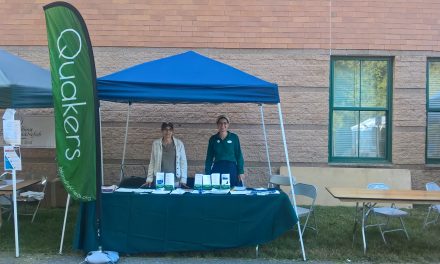When it comes to advertising, you need to start at the beginning. If you’ve decided you’re going to put up flyers, put out a banner, or run ads on Facebook, the first thing to do is to know your audience.
I know, it’s tempting to think the first thing to figure out is “what do you want to say?” What do we want people to know about us? Ok, half the time with Quakers, the answer to that is “we’re not dead yet.” So, that’s not that helpful.
And if you just give trivia and facts about Quakers, then instead if inviting people in, you’re inviting them to fall down a Wikipedia rabbit hole.

From XKCD
You’re just kind of talking at them instead of talking to them.
Talking to people
In order to talk to people, you have to know who they are. You have to know something about them. That is to say, you have to know your audience.
An example
What’s the message?
As an example, for my meeting, I think a reasonable demographic to target would be queer Christians. We have a bunch of women couples and a few trans people. We also have several people who went to seminary and speak using God-language or using the Bible during meeting. It’s a place where I feel comfortable as a queer Christian woman.
After you know your audience (“queer Christians”) you should ask:
- What do we want to say to them?
- What do they need or want to hear?
If you think we need to hear it’s time for us to repent of our queer ways, then this probably isn’t the demographic you should be targeting. That won’t make you stand out from other churches.
So, assuming you want to say the things we crave hearing, then: You are loved. God loves his queer children. There’s a place at the Lord’s table for queer Christians. You don’t have to choose between God and your sexuality. You don’t have to choose between God and your gender. Faith is for all. Maybe you’ve been burned in other churches, but we welcome you here.
Ad imagery
Notes about pictures
Ads need pictures. That’s just how it is. Practically, keep in mind that you need copyright permission for any image you use. If you’re putting someone’s face in the ad, you need specifically advertising permission from them. General “no expectation of privacy in a public space” photo use doesn’t cut it. It would be prudent to have this permission be in some form other than verbal (paper, email, even a chat log in a pinch).
If your ad is on Facebook, remember that text cannot take up more than 20% of the image’s surface area. Facebook will either bin it or severely penalize you if you break that rule. So, go for a good picture, and put just about all of (or just plain all of) the text in the caption.
Choosing good pictures
If you know your audience, it’s easier to figure out what will catch their eye. In this case, a rainbow will get attention. If you were narrowing in on transgender people as a more specific demographic, then remember: there is a more specific flag available. (Although, I have to say, Facebook does not have a way to choose transgender people as an audience, despite having added many gender options.) But a rainbow on its own is kind of meh. Do you have a rainbow flag hanging outside your meetinghouse? Or, we’re big on metaphors of light and candles, right? So, maybe a rainbow flag, curled up around a pillar candle.
Images of people are more effective than really generic images. Maybe a wedding photo from inside your meetinghouse would do? Or if people in your meeting are shy, then I could see using a stock photo from behind (because using faces that aren’t yours is a little weird) of people of the same gender, being visibly intimate. Maybe one is resting their head on the others shoulder. Or they’re holding hands. An arm draped across the other’s shoulders. These things signal affection.
Something that should be very effective would be a first person testimony, with a photo of someone from the meeting. You might quote them saying something like, “I’m so glad I found a faith community where I can be fully me: queer, Christian, loud, and silly.” You could have several variations on this.
Putting it together
Finally, your ad may need additional text. On Facebook and Instagram, there is space for this, so you should use it. While your image can only have a very little bit of text, you can write an awful lot in the caption. Go ahead. You can talk about how so many members of the LGBTQ community have found a home in your meeting, about the work you do with your local LGBTQ resource center, or about your years of service to the LGBTQ community. If you go for the personal testimony, you could have a paragraph from the person or couple in your photo.
Now you try
Ok, it’s your turn to put this into action with your meeting or church. Figure out who you want to reach (which might mean looking at your local demographics) or who God is calling you to. Here is a non-exhaustive list of demographic information you might consider.
- age range
- race
- relationship status
- has kids?
- class
- employment: unemployed, part-time, multiple part-time jobs, white collar, blue collar, student without a job, student with a job
- language
- religious background
- concerns
A good exercise might be to come up with several named personae for whom you have several of those pieces of information. Then you can ask yourself, “what would we say to Jo?” You can use those named personae in your future communications work for your meeting.
Here’s an example:
Susan is 35 years old with 2 kids. They’re in 1st and 3rd grades. She works as the receptionist at their school. Her husband travels a lot for business, and being alone so often with two small kids is a bit of a strain on her.
In the comments, try coming up with a persona or answering what your meeting has to offer and say to Susan.







Recent Comments